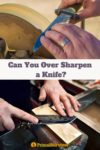Do you feel like your knives are constantly getting dull? Do you sharpen your knives every month or even every week?
You could actually be oversharpening your knives.
Here’s how to tell whether you are sharpening too much and what you should do instead.
Is It Possible to Over Sharpen a Knife?
Yes, it is possible to over sharpen a knife – especially if you use a V-sharpener, electric sharpener, or coarse diamond stone.
If you take good care of your knives, you shouldn’t have to sharpen your knives more than twice a year.
If you are sharpening more frequently than this, then you probably should be honing and stropping instead of sharpening.
What happens if you over sharpen a knife?
Here are some things that can happen if you sharpen your knife too frequently.
1. You remove the sharp edge you just created.
This occurs if you don’t know when to stop sharpening a knife. You keep sharpening even after creating a wire edge (burr), and the sharp edge ends up getting rounded over. You’ll sharpen for an eternity without the knife ever getting sharp.
2. The edge gets thicker.
Each time you sharpen a knife, a bit of the edge gets worn away. Eventually, the edge will become thick and wedge-like behind the main bevel. The blade may be very sharp, but it won’t seem sharp because a wedge shape doesn’t cut well.
To prevent this, you’ll need to thin the blade a bit each time you sharpen it. If the knife edge has already thickened because of over-sharpening, you’ll need to reprove the blade.
3. You wear the knife down to almost nothing.
It’s almost impossible to remove too much material when sharpening with a whetstone. That’s not the case with electric sharpeners. These can remove so much material that your knife blade becomes narrower until it turns into a fillet knife.
What Does It Mean to Sharpen a Knife?
While it might seem obvious, many people don’t fully understand what it means to sharpen a knife. This misunderstanding is what often leads to over-sharpening.
As eGCI explains in this wonderful guide about knife sharpening, sharpness isn’t just about creating a razor-thin edge. It’s also about getting the right shape and angle for the purpose. For example, you wouldn’t want a razor-thin edge on a chef’s knife since it would break when you tried to cut into a squash – thus making it useless.
A sharp knife can be defined as one that has a keen edge that can hold up in repeated usage while producing the results we’re looking for in the kitchen.
Sharpening vs. Honing vs. Stropping
If you are sharpening your knife frequently, chances are you should be honing it instead, followed by stropping. Here’s what the difference between these steps is.
Sharpening:
Sharpening involves removing material from the knife edge. It is only done when the knife is dull. As the material is removed and the two sides of the knife blade meet a burr or wire edge is created. This is very sharp but breaks off easily; thus, it must be removed.
Honing:
When you use a knife, the edge gets pushed out of alignment. The blade doesn’t cut as well when this happens, even though the edge is still sharp. Honing pushes the edge back in alignment.
Kitchen knives are often honed with metal or ceramic rods. These are often called “sharpening steels,” even though they don’t sharpen the knife. They should be called “honing rods” or “honing steels” instead.
Honing rods are usually used on softer metals, such as kitchen knives. Serious chefs will steel their knives before and after every use. By contrast, harder knives like ones for bushcraft are usually honed with a very smooth stone. Honing stones often have a grit of 6000 or more.
Stropping:
Stropping is the next step after honing. The process involves running the knife edge over leather or newspaper material. It polishes away any last bits of the burr and polishes the edge, making it very sharp.
How Often Should You Sharpen Your Knives?
Even if you use your knives daily, you probably only need to sharpen them once or twice a year.
You’ll know it is time to sharpen when honing and stropping don’t return the edge. Make sure you hone and strop your knives frequently. Some people hone and strop their knives after each use.
Of course, make sure you are also taking good care of your knives. Don’t put them in the dishwasher; use glass cutting boards or store them loosely in drawers. With good care and maintenance, you’ll hardly ever have to sharpen your knives.
The Type of Sharpener Matters
When it comes time to sharpen your knives, the type of sharpener matters; avoid using electric and V-shaped manual sharpeners. You’ll almost inevitably over-sharpen the knife and damage the blade with these sharpeners.
A whetstone is much better for sharpening. It’s almost impossible to take off too much material at once. Sharpening on a whetstone does take practice but is fun once you learn. Buy some cheap knives to practice before sharpening your best survival knives.
Read: Best Sharpener for Survival Knives
How Many Strokes When Sharpening?
Many knife sharpening tutorials tell you to do a certain number of strokes on each side when sharpening. You shouldn’t be counting strokes. The number of needed strokes varies too much depending on the sharpener’s coarseness, the blade’s hardness, and how hard you are pushing… Instead of counting strokes, you should feel for the burr.
After a few strokes on the sharpener, feel for the burr by running a finger across (not along!) the blade on the opposite side. Remove the burr by honing it off with gentle strokes. If you press too hard, you’ll flip the burr from side to side.
How often do you sharpen your knives? How often do you hone and strop? Let us know in the comments section below.


